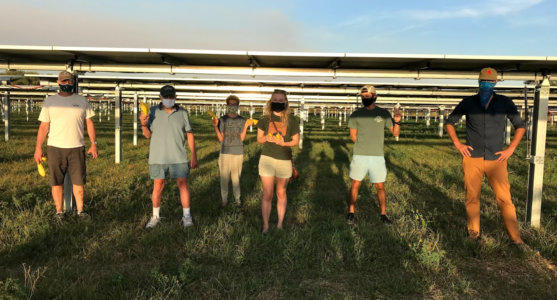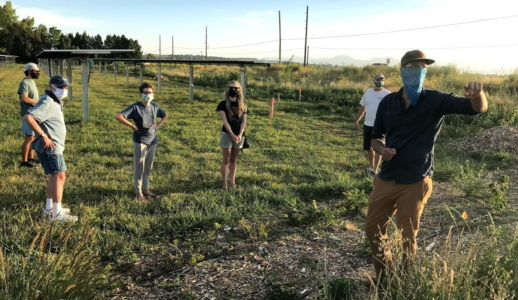In September, 350 Colorado’s Renewable Energy Committee hosted a tour of Jack’s Solar Garden in Longmont – a farm conducting research on co-locating solar panels with agriculture – called agrivoltaics. What is Jack’s Solar Garden? In Boulder County, over 3,200 solar panels will create a 1.2 MW community solar garden – enough to power over 300 homes. Jack’s Solar Garden will be a model for farmers along the Front Range on how to produce renewable energy while improving agricultural production via agrivoltaics. For more information please watch this video about Jack’s Solar Farm and this video to learn more about agrivoltaics. Thanks to 350 CO’s Renewable Energy Committee member Michael DiPaolo for today’s guest blog post!

Members of the 350 CO Renewable Energy Committee Tour Jack’s Solar Garden in Sept.
350 Colorado’s Renewable Energy Committee members recently toured Jack’s Solar Garden, courtesy of Byron Kominek, the property and project’s owner – and what we learned was both enlightening and inspiring. Jack’s Solar Garden can be looked at as a renewable energy think tank, of sorts, whose goal is to prove that clean energy can be the future of maximizing our land and resources without depreciating their value nearly as much as many current widespread practices. This shining example of what could be works with scientists, researchers, communities, educational institutions, and more to illuminate this next step. It’s claim to fame: agrivoltaics.
To quote Greg Barron-Gafford, a scientist at the University of Arizona, “agrivoltaics is a mashup of agriculture and photovoltaics (solar panels) – we’re producing food underneath the shade of solar panels [no concrete required].” During the tour, Byron showed us the ins and outs of his solar garden, explaining the riveting possibilities that agrivoltaics could deliver. Agrivoltaics creates this surprisingly effective microclimate where crops can flourish amidst the harvesting of clean energy. If you can believe it, the leaves on the plants that grow while coexisting with solar panels actually grow bigger leaves than plants grown in the open sun. The plants are healthy, growing on a farm that produces food and clean energy at the same time, getting the most use out of the land – again, without harming it.
In hot environments, where much of today’s agriculture is, watering crops in the shade can help water that is used for agriculture stay in the soil longer, allowing for drip irrigation and lessened water loss. Crops that are grown in the shade are crops that are less water-dependent than ones that are not. The shade from the solar panels alleviates the stress from the heat that our rising climate creates. Water scarcity is a very real and global problem, and since agrivoltaics is a tool that we can use to become better stewards of our undeniably-dwindling water resources, its concept makes sense.
The benefits don’t end there. Farmers and communities alike benefit from the cultivation of clean energy. Local electric companies can intake the energy that the solar panels harvest, and farmers can use the royalties to subsidize their agriculture, all while pumping clean energy into communities. It’s no secret that many farmers with the right land accept royalties for allowing big oil to drill on their land. It’s not the farmers’ fault, though. Many circumstances warrant subsidies of some sort. Well, to put a very fine point on it: agrivoltaics – clean energy fused with agriculture – could be a viable replacement for the financial relief that big oil gives to farmers.
The real kicker is: with the right capital, agrivoltaics has very real potential to be scaleable! Financially, Jack’s Solar Garden and the idea of agrivoltaics have emerged at the right time. Sustainability and renewable energy now even make sense in terms of money, in the eyes of investors.

Jack’s Solar Garden Director Byron Kominek discusses the solar garden project which will go fully live this fall.
BlackRock recently released reports pointing to the emerging edge that sustainable investments give to portfolios – and when capital is needed to fund projects like Jack’s Solar Garden, this is great news. Funding for small scale projects create a ripple effect and lead to widespread, good change. Jack’s Solar Garden furthers the proof that the world needs to take action on renewable energy concepts such as agrivoltaics.
“It’s not just a 20 year investment – it’s a long term infrastructure – the solar panels last a long time,” says Byron. Integrating solar panels into agriculture is an idea that produces long-term payoffs in energy dividends, the longevity of one’s crops, water conservation, community-based social impact, environmental impact – the list goes on. The people who want to have a better future should not turn a blind eye to innovation such as this. Investment in clean energy is key.
It was truly amazing and inspiring to see such a brilliant idea and mindset being put into action. The whole idea of Byron’s project is to be an example of how to maximize land – to get the most use out of it without damaging or exploiting it. “It makes sense,” says Byron, “to get the most use out of our land; let’s not think of land as a one-off – there are multiple things that we can do with it.”
The whole thing is a maddeningly cool idea that creates this circle of synergy in energy and agriculture, producing food and energy side by side. Being a person on Byron’s tour was a privilege. All of us on the tour agreed that it feels like we stumbled on something that is destined to be big. It’s clear that agrivoltaics should have a place in the future of agriculture – livestock as well as crops. Byron even expressed that cows would be very happy to use the solar panels as shade, just as plants can benefit from it.
The hands of the climate crisis clock are ticking and action must be made. It is such a heartening thing to see that it is. Scientists and researchers are already mobilizing around Jack’s Solar Garden, voices around the globe are being heard, legislation is being passed. This is the action that works.
Sustainable technologies and ideologies must be the future – they have to be – and Jack’s Solar Garden gives me hope that they will be. “A large intention of what we’re doing here is trying to get others to replicate this,” Byron says, “and we need the next generation to understand how to do it.”
For more information please watch this video about Jack’s Solar Farm and this video to learn more about agrivoltaics.
Michael DiPaolo is a new member of 350 CO’s Renewable Energy Committee and is a environmentalist and humanitarian with a Bachelor’s Degree from the University of Colorado Boulder. He is currently a marketer at AQUAOSO Technologies, PBC (Water Risk and Sustainability Sector).

